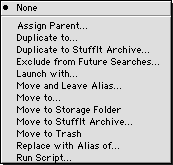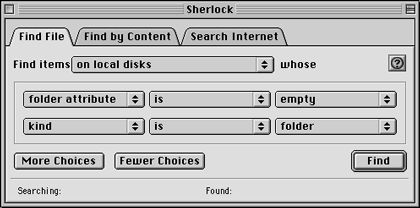Review: Spring Cleaning 3.0

Product Information
Published by: Aladdin Systems, Inc.
Web: http://www.aladdinsys.com
E-Mail: support@aladdinsys.com
Phone (831) 761-6200
Street Price: $48
System Requirements
Macintosh with 68030 or higher, System 7.1.1 or higher, at least 8 MB of available RAM
Spring Cleaning 3 is the latest incarnation of Aladdin Systems’ utility for cleaning out your hard disk. Although Spring Cleaning is now easier to use and more polished than when we reviewed it two years ago, its core functionality remains largely the same. If your Mac is more than a few years old, chances are it has accumulated some unnecessary files. Spring Cleaning is aimed at helping you with tasks like uninstalling applications, removing multiple copies of duplicate files, fixing broken aliases, and deleting orphaned preferences files.
To clean your disk, you first use Spring Cleaning to search for a particular set of files. Then you can apply one of Spring Cleaning’s actions to some or all of the search results.

- Alias Fixer searches for aliases whose originals cannot be found. Spring Cleaning presents a list of broken aliases and lets you fix or delete them. It works very well provided that you have mounted all the volumes to which your aliases point. Otherwise, Spring Cleaning will give “false alarms” because it cannot find what some of your aliases point to, even though they are still valid.
- Document Finder lets you search for all the files of a particular type. As far as I can tell, this is equivalent to using Sherlock to search by file type/creator, although Spring Cleaning does give you more options for what to do with the files once you have found them.
- Duplicates Remover finds duplicate files on your disks. You can delete the duplicates or replace all but one copy of a file with aliases. This is great for removing the extra copies of SimpleText that applications always seem to install.
- Empty Folder Remover removes empty folders. This is another Spring Cleaning function that can easily be duplicated with Sherlock.

- Fat App Slimmer searches your drives for fat binary applications—those that contain instructions for PowerPC processors as well as the original 680x0 processors. You can then “slim” down these applications by removing the code that’s unnecessary for your particular Mac.
- File Checker identifies files that may be damaged, but it does not fix them.
- Font Remover locates your font suitcases and bitmaps. Spring Cleaning can locate duplicate copies of your fonts both inside and outside your System Folder, and can remove fonts you do not use to save both disk space and memory. Font Remover works fine, but for serious font management you’ll need something more powerful like Adobe Type Manager Deluxe or Extensis Suitcase.

- Help Remover is aimed at helping you delete unneeded application help files. However, it seems to search merely by file type—locating Apple Guide, QuickView, and Acrobat PDF files. You must to be careful to scrutinize Spring Cleaning’s search results; it identified every PDF file on my hard disk as a documentation file and failed to locate many help files in DOCMaker, text, and HTML format. Obviously, Aladdin cannot be expected to make Spring Cleaning magically distinguish which PDF and text files are help files. However, since they have not done so, this function is not much more useful than a Sherlock search by file type.
- MacUninstaller is aimed at helping you remove an application and its support files. In real life Spring Cleaning’s MacUninstaller works well—better than I expected—but it is not going to be as effective as using the uninstaller that likely came with the software in the first place. (Most installers have a pop-up menu that lets you choose from Recommended Installation, Custom Installation, and Custom Remove.) No matter how much intelligence Aladdin builds into the product, there is simply no way for it to know how to uninstall every program. So why take a chance? If I can’t find the original uninstaller for a piece of software, I am more likely to take a stab at it myself or just leave the files alone than to let Spring Cleaning have a go.
- Orphan Adopter finds files that don’t “belong” to any application installed on your Mac. You can then assign “parent” applications so that the files will be double-clickable in the Finder. This is probably Spring Cleaning’s slickest feature.
- Orphaned Pref Remover lets you remove preferences files for applications that are no longer installed on your Mac. In my experience, Spring Cleaning found many preferences files that were, in fact, associated with applications on my hard disk. Had I deleted those files, I would have lost settings and been required to re-enter serial numbers, Adobe Type On Call data, and preferences from Adobe FrameMaker and Aladdin’s own StuffIt Deluxe. (Also, I could have lost all of my Navigation Services window settings.) By contrast, simply sorting my Preferences folder by modification date produced an also imperfect, but far better, list of outdated files.
Spring Cleaning often gave me “out of memory” messages, but did not explain how to fix them by allocating more application memory in its Get Info window. This is symptomatic of a larger problem: Spring Cleaning seems aimed at novices, yet requires more than a novice’s level of knowledge. To use Spring Cleaning effectively, you must have a rudimentary understanding of your system and application support files, so that you know which are safe to remove. This problem is not exactly Aladdin’s fault, nor is it something that I think is possible for them to fix. Nevertheless, it lessens the usefulness of the product and increases its potential to do harm.
Spring Cleaning does two basic things: it searches for particular groups of files and lets you do something with those files once they have been found. Neither of these abilities is unique to Spring Cleaning. Most of the searching features could be duplicated by some clever usage of Sherlock’s Find function or a shareware utility such as FileBuddy. Sherlock’s ability to save search criteria can help automate this process, after you have done it once. Spring Cleaning’s actions are all available from one convenient menu, however each could also be accomplished with the Finder or a shareware/freeware utility.
The main utility of Spring Cleaning is that it brings all these features together into one easy-to-use package. The other areas where Spring Cleaning shines are in letting you create a list of files to exclude from future searches, and in providing a means to restore (undo) actions that you’ve accidentally applied.
Spring Cleaning 3 is easier to use than earlier versions of the product and has good AppleGuide help, however it still leaves a lot to be desired. The new interface is adequate, but it is a little rough around the edges. For instance, when you click on a file in the search results view, you can see more information about it in the details pane, but the area that shows the path to the file (so you can tell which one of many identically named files it is) is short and does not scroll—so you can see only the first three levels of its path. Often this is not very helpful. Similarly, all of Spring Cleaning’s actions are available after each type of search. This makes the interface more uniform, but how much sense does it make to let the user duplicate an orphaned preferences file?
In short, Spring Cleaning 3 can save you time if you need to do an extensive hard disk cleaning. However, this cleaning is far from automatic, and often could be accomplished just as well by hand. Sherlock, Mac OS 8.5’s alias resolver, and various shareware utilities can provide much of Spring Cleaning’s functionality, at a fraction of the price. However, Spring Cleaning’s combination of “cleaners” is a good package for those who want a complete cleaning solution that’s ready to go out of the box.
Reader Comments (2)
Is there any way to get a copy of that program? It had the stuff that worked for me.
Please help me return to my workable files.
thanks
Glen
Add A Comment